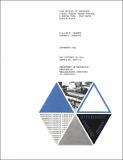Film boiling of saturated liquid flowing upward through a heated tube : high vapor quality range
Author(s)
Laverty, W. F.; Rohsenow, Warren M.
DownloadHTL_TR_1964_032.pdf (4.788Mb)
Other Contributors
Massachusetts Institute of Technology. Dept. of Mechanical Engineering.
Massachusetts Institute of Technology. Heat Transfer Laboratory.
Metadata
Show full item recordAbstract
Film boiling of saturated liquid flowing upward through a uniformly heated tube has been studied for the case in which pure saturated liquid enters the tube and nearly saturated vapor is discharged. Since a previous study at the M.I.T. Heat Transfer Laboratory covered the case in which only a small percentage of the total mass flow is vaporized, this investigation has been concentrated on film boiling in the region where the vapor quality is greater than 10 percent. Visual studies of film boiling of liquid nitrogen flowing through an electrically conducting pyrex tube have been made to determine the characteristics of the two-phase flow regimes which occur as a result of the film boiling process. It was found that the annular flow regime with liquid in the core and vapor between the liquid and the tube wall, which exists at very low qualities, is broken up at higher qualities to form a dispersed flow of droplets and filaments of liquid carried along in a vapor matrix. A stainless steel test section having a .319 inch ID and heated electrically, has been used to obtain experimental data of wall temperature distributions along the tube and local heat transfer coefficients for different heat fluxes and flow rates with liquid nitrogen as the teit fluid. Heat flux has been varied from 3500 2 to 30000 BTU/hr-ft and mass velocity from 70000 to 210000 lbm/hr-ft2. From these tests, values of wall superheat, (Tw -Ts ), from 200 to w S 975[degree]F and heat transfer coefficients from 11.1 to 65.5 BTU/hr-ft2-[degree] F have been obtained. A theoretical derivation using the Dittus-Boelter equation as an i,7mptote for the heat transfer to pure vapor has demonstrated that a significant amount of vapor superheat is present throughout the film boiling process. The mechanism of the heat transfer process in the dispersed flow region has been described by a two step theory in which 1) all ofthe heat from the wall is transferred to the vapor and 2) heat i
Date issued
1964Publisher
Cambridge, Mass. : M.I.T. Dept. of Mechanical Engineering, [1964]
Other identifiers
14088421
Series/Report no.
Technical report (Massachusetts Institute of Technology, Heat Transfer Laboratory) ; no. 32.
Keywords
Boiling-points., Pipe -- Fluid dynamics., Heat -- Transmission.